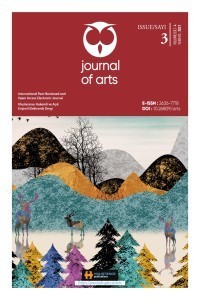PLATON’UN SANATÇILARI VE ZANAATKÂRLARI: MİMESİS ÜZERİNE BİR İNCELEME
idealar kuramı, sanat, mimesis, tiyatro
PLATO’S ARTISTS AND ARTISANS: A REVIEW ON MIMESIS
theory of forms, art, mimesis, theater.,
___
- ARİSTOTELES (2012). Poetika, çev. İsmail Tunalı, İstanbul: Remzi Kitabevi.
- BURCKHARDT, J. J. (1928). The civilization of the Renaissance in Italy, Crows Nest: G. Allen & Unwin, ltd.
- BROCKETT, O. G., & Bayramoǧlu, İ. (2000). Tiyatro Tarihi, Dost Kitabevi.
- DOLEZEL, L. (2000). Heterocosmica: Fiction and possible worlds, JHU Press, 2000.
- ERVINE, St. J. (1928). Introduction. Complete Works of William Shakespeare, London & Glosgow: Collins Clear Type Press.
- ESSLIN, M. (1972). Theatre of the Absurd. Penguin books Limited.
- FARRELL, J., & Puppa, P. (Eds.). (2006). A History of Italian Theatre, Cambridge: Cambridge University Press.
- GOETHE, J. (1798). Einleitung in die Propyläen. Propyläen, I.
- MANSFIELD, E. (2007). Too Beautiful To Picture: Zeuxis, Myth, and Mimesis, Minneapolis: University of Minnesota Press.
- PLATON (2005). Devlet çev. C. Saraçoğlu & Veysel Atayman, İstanbul: Bordo-Siyah Yayınları.
- PLINIUS (1961). Natural History, 9, 33-35, trans. H. Rackham, Cambridge: Harvard University Press.
- POTOLSKY, M. (2006). Mimesis, New York, NY: Routledge.
- THOMSON, J. A. K. (1915). The Greek Tradition: Essays in the Reconstruction of Ancient Thought, Crows Nest: G. Allen & Unwin Limited.
- ISSN: 2636-7718
- Başlangıç: 2018
- Yayıncı: Holistence Publications
SAFAVID CERAMICS THROUGH THE EYES OF EUROPEAN TRAVELLERS
WHAT’S IN A NAME? EXPERIMENT ON THE AESTHETIC JUDGMENTS OF ART PRODUCED BY ARTIFICIAL INTELLIGENCE
GRAFİK TASARIM EĞİTİMİNİN ÇAĞIN GEREKLERİNE UYGUNLUĞUNA İLİŞKİN ÖĞRETİM ELEMANLARININ GÖRÜŞLERİ
PLATON’UN SANATÇILARI VE ZANAATKÂRLARI: MİMESİS ÜZERİNE BİR İNCELEME
KÜLTÜREL DEĞİŞİMLER İLİŞKİSİNDE POST-DİJİTAL SANAT: SINIR İHLALLERİ
